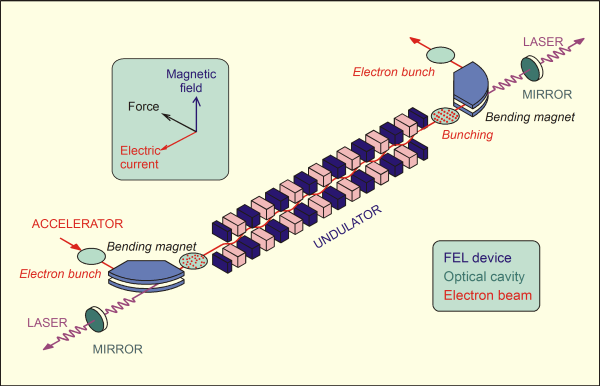
Free-Electron Laser
Right figure shows a conceptual arrangement for generation of a free-electron laser (FEL). When a high-brightness electron beam goes through an undulator with a light beam, it is micro-bunched through interaction with the electromagnetic field of light, and the light beam is amplified to become a coherent laser. The FEL is widely tunable even in wavelength region where conventional lasers cannot reach.

Conceptual drawing of a compact and economical free-electron laser system:
Free-electron laser is regarded as a light source of the next generation because of its wide wavelength tunability, potential high efficiency and high power, and possibility of lasing at wavelength regions where the conventional lasers cannot reach. However, the system is much bigger and the cost is higher than conventional lasers. We are going to overcome these difficulties by exploiting and RF (radio-frequency) gun, energy recovering system, etc.
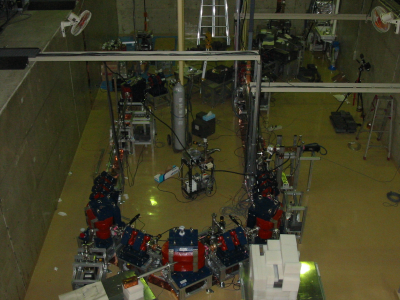 We are constructing an IR-FEL facility based on a conventional S-band linac.
A 4.5 cell thermionic RF gun, a 3-m accelerator tube, and a beam transport system
have been installed, and we have started commissioning for lasing of FEL.
The KU-FEL is designed to achieve a FEL lasing from 4 to 13 Κm during the first stage.
The tunable IR laser will be used for basic study of high-efficiency solar cells,
generation of sustainable energy source, separation of DNA and/or RNA, etc.
We are constructing an IR-FEL facility based on a conventional S-band linac.
A 4.5 cell thermionic RF gun, a 3-m accelerator tube, and a beam transport system
have been installed, and we have started commissioning for lasing of FEL.
The KU-FEL is designed to achieve a FEL lasing from 4 to 13 Κm during the first stage.
The tunable IR laser will be used for basic study of high-efficiency solar cells,
generation of sustainable energy source, separation of DNA and/or RNA, etc.
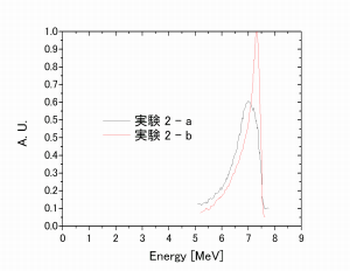 Iimprovement of thermionic RF gun
It is necessary to develop a high-quality electron source which is compact and easy
to operate for a compact and economical FEL device. We have improved a thermaionic RF gun,
which was difficult to produce high-energy electron beam with long macro-pulse,
and successfully produced long macro-pulse electron beam suitable for an FEL experiment.
Iimprovement of thermionic RF gun
It is necessary to develop a high-quality electron source which is compact and easy
to operate for a compact and economical FEL device. We have improved a thermaionic RF gun,
which was difficult to produce high-energy electron beam with long macro-pulse,
and successfully produced long macro-pulse electron beam suitable for an FEL experiment.
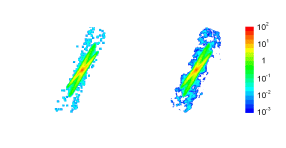 Evaluation of phase space distribution of the electron beam using tomography technique
Evaluation of phase space distribution of the electron beam using tomography techniqueA computer tomography technique has been applied for the precise measurement of the transverse phase space distributions of the electron beam. This method gives detailed phase space information and is suitable for the case of thermionic RF gun whose phase space distribution is non-Gaussian.
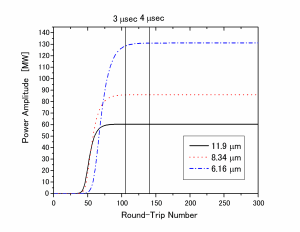
FEL simulations
The optimization of electron beam parameters and the design of the optical cavity have been numerically carried out in order to obtain high FEL gains in the KU-FEL facility. The FEL power saturation in 6`12 Κm wavelength is expected with the optimized condition.
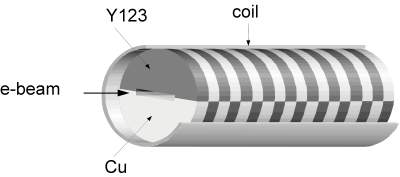
Development of a new type of undulator
We have started study of a new type of (staggered-array) undulator using superconducting material. Application for a micro-undulator ( period length is less than 10mm) is expected.



